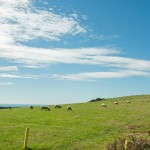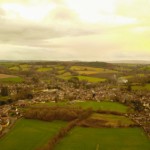
Padstow is a small town, fishing port and civil parish on the north coast of Cornwall in the southwest of England. The town lies on the west bank of the estuary of the River Camel, approximately 5 miles (8 km) northwest of Wadebridge, 12 miles (20 km) northwest of Bodmin and 12 miles (20 km) northeast of Newquay. The historic port is now perhaps best known for being home to a number of high-profile celebrity chefs and restaurants, along with its outlandish May Day celebrations. The population of the civil parish of Padstow at the 2011 national census was 2,993.
Padstow A Fleeting History
It is thought that Padstow’s natural harbour was utilised as early as 2500 BC linking Brittany with Ireland, along the ‘Saints Way’ from Fowey. The locally influential St Petroc arrived from Ireland around 520 AD. He chose the site for Padstow Monastery on a hill overlooking the harbour, which was built by monks after his death. He was to give his name to the settlement that eventually developed, originally called Petroc-stowe, which translates as Petroc’s place.
In 981 AD, according to the Anglo-Saxon Chronicles, Padstow was raided by Vikings. It is thought as a result of the attack, monks from the monastery decided to move inland to Bodmin, taking with them the relics of St Petroc.
In 1086, Padstow is recorded in the Domesday Book as being in the ownership of Bodmin Monastery. The ‘Great Survey’ reputedly valued the 24 acres of pasture land and 6 smallholdings at a total of 10 shillings (50p). During the Middle Ages, Padstow continued to grow in importance, exporting copper, tin, lead, slate, pilchards and agricultural produce, mainly to Ireland, whilst it imported coal, timber and salt from Wales.
During the 13th century, Padstow’s current St Petroc’s Church was built. It is one of four in the locality built on sites that are thought to have been founded by St Petroc, the others being at Little Petherick, Parracombe and Bodmin.
Monasteries No More
After 1541, when Henry VIII’s Dissolution of the Monasteries had been realised, the land on which Padstow Monastery had stood was handed to local nobility, the Prideaux family. In 1592, the eponymously named Prideaux Place, a fortified manor house, was built by Nicholas Prideaux. It survived largely unchanged up until the mid-18th century, when, following a tour of Italy in 1739, Nicholas Prideaux’s great-grandson Edmund, decided it was time to refurbish the old house. Drawing inspiration from his Italian adventure, he also commissioned a formal garden befitting the house.
Around 1600, Sir Walter Raleigh moved to Padstow to take up his brief tenure as Cornwall’s Member of Parliament. He also served as the Governor of Jersey around the same time. The Court House at Riverside where he lived was made the administrative centre for the collection of local taxes and other levies. The house still stands by the harbour to this day.
Over the years Padstow continued to thrive, especially in its maritime activities, meaning by the turn of the 19th century it had six shipyards. One great advantage had was that it was able to use slipways, rather than the more expensive method of dry docks, to construct and maintain shipping. In 1829, the Padstow Harbour Association was formed, in particular, to take control of improving the access to the port.
In 1844, the present-day Padstow Harbour Commission was established, superseding the Harbour Association, to oversee port regulation and further improvements of the harbour. However, by 1886, things were in serious decline, with the ‘Amaranth’ being the last ship built at Padstow. However, the last of the shipyards did manage to stay open, repairing and refitting small sailing ships, up until the late 1890s.
American Exodus
Like many coastal towns in the region, Padstow served as a departure centre from Britain for those searching for a better life, especially to North America. In 1841, the numbers departing from Padstow for a new life in Canada, specifically Quebec and Prince Edward Island, was only surpassed by those leaving from London and Liverpool. These numbers were no doubt greatly enhanced by the fact that ships arriving with a cargo of timber from Canada were offering cheap one-way fares on their return trip to any would-be migrants.
By the 1880s, the town’s shipbuilding industry was in steep decline due to the rise of the new-fangled iron ships. However, the coming of the railway in 1899, proved to be a stroke of good fortune for Padstow. The building of an ice factory and new fish packing shed at the dock’s Lower Yard soon followed. With the town now having the ability to transport fish quickly to London’s markets, the demand for docking in the harbour from fishing vessels greatly increased. The railway also gave a big impetus to tourism throughout the Trevone Bay area, greatly increasing connectivity, especially with London.
In 1910, the present-day dock was built, greatly expanding the town’s dockland facilities and making Padstow the centre of the local fishing industry. In 1932, the New Pier was built within the docks Inner Basin to help provide more shelter for mooring vessels against the sometimes harsh elements.
On 1 January 1948, Padstow railway station, then under the jurisdiction of Southern Railway fell into the ownership of British Railways, under the county’s nationalisation programme. On 30th January 1967, the station and railway line were closed for good, as recommended under the Beeching Report of 1963.
Modern Era
While Padstow owes its existence to its maritime past, especially fishing, the town’s economy is now much more dependent on tourism. While still retaining a modest fishing fleet, its location on the only sizeable estuary on the north coast of Cornwall also ensures its popularity with the affluent yachting fraternity. The fact that a number of celebrity television chefs have chosen to set up restaurants in Padstow, has only added to the town’s vogueish and sophisticated image, making it somewhat of a local mecca for tourists.
Accordingly, visitor numbers during the summer months can often reach more than 5,000 on a daily basis. However, the town also tends to maintain a good level of tourism throughout the year, with visitor numbers annually, exceeding 500,000.

Padstow Harbour caters for both the fishing industry and leisure activity Photo credit: Wirestock Images/Shutterstock.com
The downside of the area’s boom in popularity is that Padstow has become a particular target of those looking to buy a second house or holiday home. Research carried in 2018 found that two-thirds of all houses sold in the Padstow area in the previous 2 years, had been bought up as second homes. As with other many other popular tourist spots, the problem is that the law of ‘supply and demand’ has dictated that house prices in the town have become greatly inflated making them unaffordable for local residents. Understandably, this situation often leads to resentment from the relatively poorly paid locals towards the ‘wealthy’ incomers.
With more than 100 listed buildings in the parish, Padstow retains much of its Medieval/Elizabethan character. St Petroc’s Church, Prideaux Place and Abbey House are recognised as being the town’s most significant buildings.
Getting to Padstow
By Air
Padstow is only a 12-mile drive away from Newquay Airport. There are currently 9 airlines that fly to/from Newquay Airport making it an easy way to get to your destination. There are regular flights to and from London. The next nearest airport is Exeter which is about 95 miles and about 1 hr 45 mins away by road.
By Bus
There are numerous connections to/from London, Birmingham, Bristol and many other places nationwide to Cornwall available with National Express. To get to Padstow using National Express change for local bus services at either Liskeard or Bodmin Parkway.
By Car
If you are driving down to Padstow, then the best way for the majority will be to take the M4 to Bristol then head south on the M5 to Exeter. Next, turn off for the A30 to Cornwall, turning then turn off at Bodmin for the A38 and then on to the A389 for Padstow.
By Rail
The nearest train station to Padstow is Bodmin Parkway with trains being operated by First Great Western Railways. Trains running all year round, 7 days a week from London, Bristol, Birmingham, and many other destinations. Frequent buses run the 19 miles between Bodmin Parkway and Padstow operated by the Western Greyhound Bus service.
Getting around
Western Greyhound buses operate a vast network of local bus services across Padstow and the surrounding areas.
The Obby Oss Festival
May Day or the ‘Obby Oss’ Festival is perhaps the most anticipated day in the Padstow calendar. When the day arrives, it’s known for upwards of 30,000 people to cram the streets of the small town. There are numerous theories on the origins of Obby Oss (hobby horse) Day, but most pundits seem to believe it to be rooted in a fertility rites celebration dating back to pagan times.
At midnight on April 30th, locals begin the process of decorating the town’s streets with flags, flowers and greenery, and then erect a maypole. The following morning two “osses”, one red and one blue, emerge from their stables on to the streets. The “osses” then proceed to cavort and frolic through Padstow’s streets taunted by a Teazer, who heads up the theatrical procession.
The accompanying entourage all dress in white, with their costumes being decorated with ribbons and sprays of wildflowers. As the parade moves through the town, it’s joined by dancers who then perform traditional gyrating movements to the sound of the accompanying accordionists and drummers. The evergrowing procession is then joined by the ‘followers’, young and old alike, who then all proceed to sing the traditional May Song, which signals the close of festivities until the following year.
Notable Padstow residents
A few of Padstow’s notable residents of past and present include:
Sir Walter Raleigh (1554 – 1618) – writer, poet, soldier, politician, and renowned explorer, lived in Padstow, circa 1600 to 1603.
Rick Stein – celebrity chef and TV personality, has lived in Padstow since 2009, and now runs several restaurants in the town.
Paul Ainsworth – Michelin starred chef and TV personality, runs several businesses in Padstow.
Gordon Ramsey – celebrity chef, restauranteur and TV personality bought a second home in Padstow in 2015.
Edward Woodward (1930 – 2009) – well known British film/TV actor and singer, lived the latter part of his life in Padstow and is buried in the town cemetery.
Things to see and do In & Around Padstow
Walking and Cycling
- South West Coast Path – 630 miles in total, it runs along both sides of the River Camel estuary and crosses from Padstow to Rock via the 10 minute Black Tor ferry trip.
- Saints’ Way – is a 27 mile (43 km) footpath that runs along the coast from Padstow to Fowey. It forms part of the much longer Cornish Celtic Way.
- Camel Trail – follows the route of the former North Cornwall Railway so there are no steep inclines along the 17-mile route. It starts in Padstow, passing through Wadebridge, Bodmin and then to the village of Blisland on Bodmin Moor, following the course of the River Camel. Stunning scenery with plenty of wildlife!
Places to see
- Church of St Petroc – The present-day 15th-century church is the third on the site. There are a notable 15th-century font and 16th-century pulpit, as well as the general architecture. There are also several monuments dedicated to various members of the Prideaux family.
- Prideaux Place – built overlooking Padstow in 1592, the grand Elizabethan country house has formal gardens and deer park.
- Padstow Harbour – the ferry, boat trips and fishing vessels all leave from the harbour. And, with no shortage of cafes and shops, a good place to ‘chill out’ for a few hours.
Things to do
- Take a boat trip – there are numerous boats that run up and down the coast from Padstow harbour. The most popular trips are angling and wildlife trips. Seals, dolphins, puffins and basking sharks can all be spotted
- Visit Rock – which is a village, upmarket resort and local hang-out of the rich and famous. It’s only a 10-minute ferry ride away across the Camel estuary.
- Head to the beach – only a short walk from the harbour you’ll find golden sandy and relatively secluded beaches such as St George’s Cove, Daymar Bay, Hawker’s Cove and others.
Where to stay?
There’s a very limited amount of accommodation actually in or even close to Padstow. If you want to stay in the town itself expect to pay of £150 – £250 for 2 adults sharing a hotel room. You could consider staying in Wade bridge (4 -5 miles) or Port Isaac (4 or 5 miles) which should be a little cheaper. If you stay in Newquay (10 – 12 miles) you can take your pick from a wide range of accommodation options.





